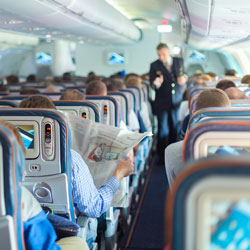 Regardless of your line of business, your organization may have a middle seat that needs fixing.
Regardless of your line of business, your organization may have a middle seat that needs fixing.
Along with the quality of food (or lack thereof), the indifferent treatment of staff, late arrivals and lost luggage, the middle seat is one of the issues airplane passengers find most annoying.
It is woeful (and sometimes funny) to watch the look of surprise, disappointment and even outrage on passengers’ faces when they realize they’ve been assigned this discredited seat. Expressions like “This isn’t happening!” and “You’ve got to be kidding!” are very common during the boarding process in airlines all over the world.
The middle seat is unquestionably an element that generates bad flight experiences and that causes a negative impact on customer satisfaction. However, you’d be surprised to learn that airlines are not the only companies that “offer” a middle seat. In fact, I dare say every business has one.
I use the term ‘middle seat’ to refer to those things, people, places or moments about a company that customers frown upon and try to avoid at all costs. In other words, the middle seat is any aspect of your organization (product, service, facilities, website, etc.) that provokes in your customers the same feelings of frustration and anger described above.
But, why do airlines and most companies in all lines of industry offer a middle seat? There are many reasons: maybe the product or service were misconceived from the get-go, maybe nobody ever listened to the customer’s voice, maybe it’s sheer indifference on the organization’s part, or maybe it’s something that can’t be helped.
Whatever the reason, rooting out or at least improving middle seats is decisive to stay competitive in the market.
Spotting middle seats is not a hard task. All it takes is asking customers a few simple questions and listening carefully:
What bothers you most about doing business with our company? What is it that you most want to avoid when dealing with us? Which characteristic of our product or service would you say most affects your experience? If you had to improve only one thing about us, what would that be?
Having all this information is critical but worthless if we don’t capitalize on this insight. Not knowing what bothers our customers and undermines their experience is incompetence, but knowing and doing nothing about it is negligence.
For this reason, once we manage to pin down the problem, we must act. In other words, seek a customer-focused solution.
If you and your team decide to take the challenge seriously, embrace a positive attitude, brainstorm some ideas and keep the customer always present in your mind, I can assure you that you will find different alternatives to improve the situation.
For example, an airline could allow passengers travelling in the middle seat to check two suitcases instead of one at no extra cost. Another possibility could be offering some extra miles in their loyalty programs.
Regardless of your line of work, your organization has a middle seat that affects your brand image. Going out of your way to improve it is part of a customer-focused culture and will definitely help you set your company apart from the competition.
About the Author
Fernando Krasovitzky is the Managing Director of Leventer Group.




